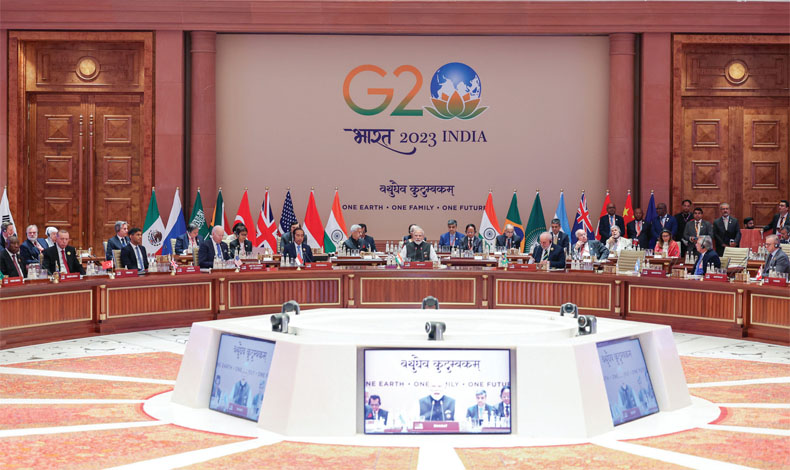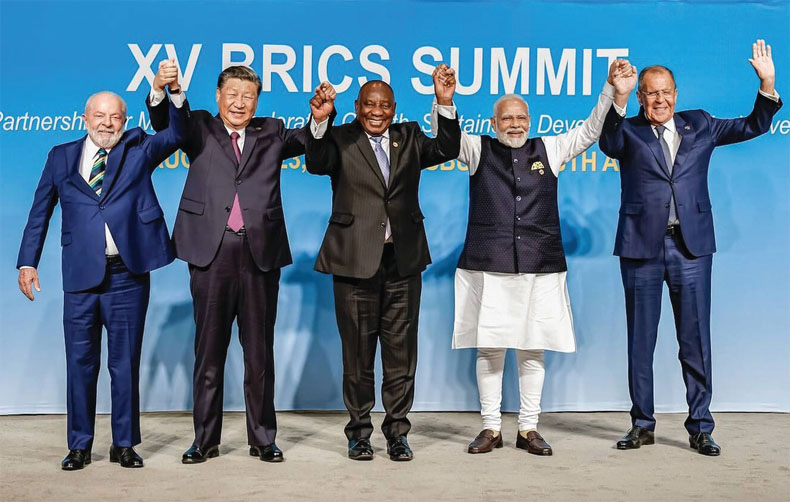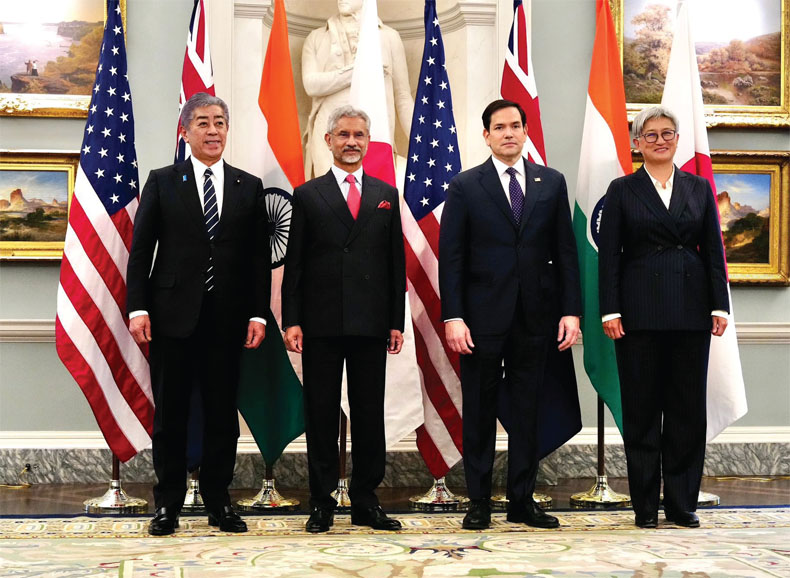As the clock counts down to August 1, when US President Donald Trump’s “Liberation Day’ tariffs kick in, we face a world changed beyond recognition where America is riding roughshod over not just countries, but upending the post-war establishment of multilateral agencies.
Starting with the United Nations where veto powers are making a mockery of the UN charter, or the G-7 and G-20 and other regional groupings that have been roiled by US President Donald Trump’s tariff pronouncements and his America First policy, multilateralism faces its most serious threat in decades. How is India affected and is there a way forward?
Never in the last 80 years has the world faced such an existential crisis in terms of the threat to the global economy and, with it, the cornerstones of multilateralism. Since the end of the Cold War, the United States has largely been expected to preserve the country’s position as the leader of the liberal international order or adjust to a multipolar world. But as Michael Buckley of Tufts University wrote in an article in Foreign Affairs: “the most likely trajectory was always a third option: become a rogue superpower, neither internationalist nor isolationist but aggressive, powerful, and increasingly out for itself.” Trump has given this dystopian vision sharp definition by raising tariffs to unprecedented levels that threatens to upend the global economy as he promotes his agenda of America First. A wide spectrum of global leaders has been making a beeline for the White House trying to strike trade deals which are more liberal than the ones Trump originally announced. India, on that list, was looking at a 26 per cent tariff on goods imported to America. A team of Indian negotiators led by Industry and Commerce Minister Piyush Goyal returned from Washington after prolonged talks, trying to ensure better terms and Trump admitted that a deal with India was “pretty close’, without going into details. Beyond that, the larger threat to multilateralism is what is causing the most concern.
The Threat: How Serious
The UN Charter was signed exactly 80 years ago and was declared “An instrument of international law, and UN Member States are bound by it. The UN Charter codifies the major principles of international relations, from sovereign equality of States to the prohibition of the use of force in international relations.”

Today, as the world faces multiple threats to global stability, militarily and perhaps, more crucially, the world’s economic architecture, multilateralism stands at an uncertain crossroads. As British historian Peter Frankopan wrote recently: “We are living in an age of revolutions—digital, demographic, climatological, military, pathogenic, economic and geopolitical.” A recent article in The Economist was co-authored by former UN secretary general Ban-Ki-moon and Helen Clark, former prime minister of New Zealand and head of the United Nations Development Programme (UNDP). They wrote: “The UN is slipping into dysfunction as some of its traditional champions, most notably the United States, retreat from multilateral co-operation, cut funding and disregard the rule of law when it suits them. This is nowhere more glaring than the security council…permanent members either involved in conflicts from Iraq to Ukraine and beyond, and has failed to prevent many conflicts over the decades.’
Since the end of the Cold War, the United States has largely been expected to preserve the country’s position as the leader of the liberal international order or adjust to a multipolar world. But as Michael Buckley of Tufts University wrote in an article in Foreign Affairs: “the most likely trajectory was always a third option: become a rogue superpower, neither internationalist nor isolationist but aggressive, powerful, and increasingly out for itself.” Trump has given this dystopian vision sharper definition.
During the Finance Ministers’ and Central Bank Governors’ meeting under South Africa’s G20 Presidency at Cape Town last month, South African President Cyril Ramaphosa declared that: “The erosion of multilateralism presents a threat to global growth and stability” and called for a rules-based order for economic stability, sustained growth, for managing disputes and resolving global conflicts. The G20 was founded on the principle of cooperation, Ramaphosa told the meeting attended by leaders in finance from across the globe. The G20 comprises some of the world’s major economies and also the European Union (EU) and African Union (AU) representing about 80 per cent of global GDP. Ramaphosa asserted that it was vital to ensuring that the rights and interests of the vulnerable are not trampled beneath the ambitions of the powerful. “Multilateral cooperation is our only hope of overcoming unprecedented challenges, including slow and uneven growth, rising debt burdens, persistent poverty and conflicts.”
How serious is the threat was visible during the BRICS summit in 2024 (the grouping includes Brazil, Russia, India, China and South Africa, along with Saudi Arabia, Egypt, United Arab Emirates, Ethiopia, Indonesia, and Iran) when Trump threatened to impose extra tariffs on BRICS countries. “Any Country aligning themselves with the anti-American policies of BRICS will be charged an ADDITIONAL 10% Tariff. There will be no exceptions to this policy.” Trump said in a post on Truth Social. This was in response to a BRICS proposal which called for an alternative to the US dollar as the world’s reserve currency backed by a basket of their respective currencies. Some financial analysts point to the creation of the euro in 1999 as proof that a BRICS currency may be possible. However, this would require years of preparation, the establishment of a new central bank and an agreement between the five nations to phase out their own sovereign currencies; it would most likely also need the support of the International Monetary Fund to be successful internationally. Moreover, none of the BRICS countries would like to bear an additional 10 per cent tariff on their exports to the world’s biggest market.
Can American Unilateralism be Countered?
India has been a leading advocate of the Global South and has tried to highlight its growing importance. The “Global South” is a term used to broadly categorize countries, primarily in Africa, Asia, and Latin America, that are often characterized as developing or less developed. It’s not a strictly defined geographical area, nor a formal political or economic bloc, but rather a concept that highlights shared experiences of socioeconomic and political challenges, particularly in relation to the Global North.
In July, India’s Prime Minister Narendra Modi undertook a five-nation tour of Ghana, Trinidad and Tobago, Argentina, Brazil, and Namibia. The visit was aimed at reinforcing India’s bonds across the Global South, strengthening partnerships on both sides of the Atlantic, and deepening engagements in the multilateral platforms such as BRICS, the African Union, ECOWAS and the CARICOM.

The Global South can be a powerful force in revitalizing multilateralism, not only through its own collaborative efforts but also by influencing global norms and institutions. Collectively, it has economic and military heft, but it needs to adopt a strategic approach, focused on priorities, strong coalitions, and coordinated action. Despite internal differences, BRICS, which represents the Global South, has shown the ability to converge on key agendas, especially when it comes to defending multilateralism, dialogue, and strengthening its voice in global affairs. It has sought to consolidate its own financial instruments created within the bloc: the New Development Bank (NDB), which focuses on financing sustainable and infrastructure projects, and the Contingent Reserve Arrangement (CRA), designed to offer support to members in times of currency pressure.
The Brazilian presidency has also proposed that BRICS advance in building a common position on the role of the World Trade Organization (WTO), strengthening the collective commitment to a more balanced, transparent, and open global trade system, which values economic multilateralism as the foundation for development. The NDB, founded in 2014, already shows solid results. According to the Evaluation Lens report, nearly all of the 11 projects assessed received “strongly satisfactory” ratings in impact, sustainability, and efficiency, demonstrating that it is possible to create effective institutions outside traditional power centres.
As Siddiqui writes in Modern Diplomacy: “The Global South can be a powerful force in revitalizing multilateralism, not only through its own collaborative efforts but also by influencing global norms and institutions. However, to dismantle the longstanding inequalities within these structures, a strategic approach is essential, requiring focused priorities, strong coalitions, and coordinated action. A fundamental goal must be the modernization of the UN Charter, specifically its provisions governing the UN’s core functions, to better prepare it for the complexities of the 21st century.”
As former UK Prime Minister Gordon Brown wrote in the Guardian recently: “If we are to have anything approaching a values-based order we will have at some point to agree an updated global charter for our common future, something that builds on the Atlantic Charter of 1941 and the UN Charter of 1945, but is geared to a completely different century.”
India’s Way Forward
For Indian policy makers and its leadership, how damaging would Trump’s threat of 100 per cent sanctions on buyers of Russian oil, a threat backed by the EU, have on India? Currently, India buys over 35 per cent of its oil from Russia because of the heavy discounts offered by Moscow following the invasion of Ukraine and punitive action by the West against the Russian economy.
In response, Petroleum Minister Hardeep Singh Puri said India is not concerned about sanctions on Russian crude, as there are enough supplies in the market. “I’m not worried at all. If something happens, we’ll deal with it. India has diversified its sources of supply. We’ve gone from buying oil from about 27 countries to around 40 now.”

India will obviously have to pay more for its oil imports since Russian crude is currently the cheapest for major buyers like India and China, but the dent in the Centre’s pocketbook may not be that severe. India, in the words of mandarins in South Block, will balance its interests and priorities in a spirit of “cynical realism,” a mantra now in fashion in New Delhi’s power circles. That basically means covering all bases that could put a cramp on its impressive GDP growth, making it the fastest growing major economy.
That strategy has meant India’s defence ties with US and European firms have registered a sharp rise in recent months with the government opening up the sector to private players for collaboration with western defence manufacturers. In July, Defence Minister Rajnath Singh and his American counterpart Pete Hegseth agreed to firm up a 10-year framework to further expand defence and strategic ties between India and the U.S. A Pentagon statement read: “Secretary Hegseth emphasised the priority the United States places on India as its key defence partner in South Asia.” The US has cleared a proposal to supply critical military hardware and logistic support assets worth USD 131 million to India. The approval for the supplies came amid the Donald Trump administration pushing New Delhi to increase its military procurement from the US. The proposed supplies through the “foreign military sale” route are linked to the India-US cooperation under the framework of the Indo-Pacific Maritime Domain Awareness programme.
Apart from forging closer military ties with the West (France is also a major weapons supplier and some major joint ventures with the private sector have been signed recently), India has also signed a Trade and Partnership Agreement (TEPA) with the European Free Trade Association (EFTA). The pact includes EFTA member states Iceland, Liechtenstein, Norway, and Switzerland and is expected to be a major driver of foreign investment and bilateral trade. A dedicated India-EFTA Desk has been established to ensure smooth rollout and effective coordination. The platform is designed to serve as a single-window facilitation mechanism for both public and private sector stakeholders, aiming to make it easier for EFTA-based investors to engage with Indian markets. Under the TEPA framework, India aims to attract $100 billion in foreign direct investment (FDI) over a 15-year period. The target includes an initial $50 billion over the first decade, followed by an additional $50 billion in the subsequent five years. The agreement is among the most comprehensive trade pacts India has signed to date. It is expected to provide Indian exporters with greater access to high-value European markets, while also bringing in advanced technology, capital inflows, and employment opportunities.
New Delhi is also giving priority to QUAD, the grouping that comprises America, Australia, India and Japan. In recent years, the group has become a counterweight to China’s increasing aggressiveness. In July 2025, a joint statement by QUAD members condemned the April 22 terror attack in Pahalgam and called for the perpetrators, organisers, and financiers of the attack to be brought to justice without delay. Though not naming Pakistan explicitly, the group’s call aligned with growing international concern over cross-border terrorism. The statement marked a clear show of solidarity which India can build upon. The four Quad members have played a major role in purposefully redefining the “Asia-Pacific” as the “Indo-Pacific”, to deepen trans-regional ties between the Indian and Pacific Ocean areas.
However, India faces the challenge of participating in QUAD while maintaining a delicate balance with China, which has shown signs of a thaw in recent months. It is in New Delhi’s interests to ease tensions with China and, at the same time, forge closer ties with countries like Japan, Brazil and the US. As political scientist Oliver Stuenkel writes in the Indian Foreign Affairs Journal: “Instead of focusing on status, as it has often done in past decades, India’s foreign policy is likely to become more pragmatic. For example, rather than engaging in fixed partnerships, India will pursue its national interest in its growing sphere of influence, and align with whomever it deems convenient – be it other emerging countries such as Brazil in one moment, and the United States in the next.”
ABOUT THE AUTHOR
 Dilip Bobb is a former senior managing editor, India Today (1975 -2010), and Group Editor, Features and Special Projects, Indian Express (February 2011-October 2014)
Dilip Bobb is a former senior managing editor, India Today (1975 -2010), and Group Editor, Features and Special Projects, Indian Express (February 2011-October 2014)





